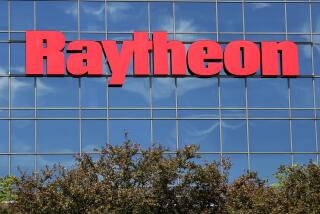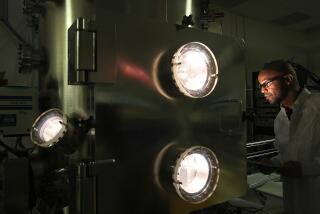Raytheon Unit Shows Up on Radar
- Share via
For a while, Raytheon Corp.’s sprawling defense-electronics operation in El Segundo, which develops everything from radar systems to spy equipment, seemed more like a financial albatross than a cash cow.
After paying an exorbitant $9.5billion for the business, Raytheon has had to jettison several businesses to pay down the debt and avoid having its credit rating drop to junk-bond level.
The operations are part of the legacy of Howard Hughes that General Motors Co. acquired a decade earlier in its $5-billion acquisition of Hughes Aircraft.
Cultural differences hindered prospects for a smooth and quick integration as Raytheon’s centralized management style clashed with aloof engineers accustomed to having headquarters stay out of their way.
But in the last few weeks, thanks in part to renewed focus on defense and homeland security after the Sept. 11 terrorist attacks, top Raytheon executives are seeing the business in a more favorable light, and that may bode well for the aerospace industry in Southern California.
Last week, Raytheon Chief Executive Daniel P. Burnham gave the Electronic Systems unit a glowing endorsement as he announced he was selling the company’s aircraft modification and repair division so it could focus on businesses that have been central to the electronic unit’s growth.
The Electronic Systems unit, which also has major operations in Arizona, Texas and Massachusetts, is headquartered in El Segundo and employs 35,000 people, with about a quarter based in Southern California. About 6,500 engineers work in El Segundo while nearly 2,000 work in Goleta and about 500 in San Diego.
*
President Proposes Defense Spending Hike
On Wednesday, the Raytheon unit got even a bigger boost from President Bush as he proposed the biggest defense spending increase in more than two decades.
“We will invest in more precision weapons, in missile defenses, in unmanned vehicles, in high-tech equipment for soldiers on the ground,” Bush said, citing core areas of business for Raytheon. “The tools of modern warfare are effective. They are expensive. But in order to win this war against terror, they are essential.”
The remarks could not have been more timely.
A week earlier, Burnham had noted that the sale of the aircraft repair business “represents a major step in our strategy to focus on growth in key areas such as missile defense; intelligence, surveillance and reconnaissance electronics, precision-strike weapons systems and homeland defense.”
“This transaction provides us financial flexibility and the strategic resources to dedicate to these markets,” he said.
Four areas of growth have been cornerstones of the El Segundo operations:
* Developing radars and kill vehicles to defend against ballistic missiles.
* Making spy components for intelligence gathering.
* Assembling missiles and precision-guided bombs.
* Developing new devices to detect terrorists.
“What’s the core? What’s this company all about? It’s about businesses in El Segundo,” said Byron K. Callan, an aerospace analyst with Merrill Lynch & Co. “That’s the heart and soul of their business. It is by far the most desirable part of their portfolio.”
Indeed. Though revenue has been growing at an average of about 6% to 7% annually, operating margins have been in the range of 10% to 12%, nearly double the industry average, said Paul H. Nisbet, an analyst with JSA Research Inc.
In reporting the company’s fourth-quarter earnings Wednesday, Burnham said the Electronic Systems unit had actually posted operating margins of nearly 14% and that the company’s defense sales had jumped by more than 10%.
“We believe we have some of the best margins in the industry,” William H. Swanson, president of the unit, said during an interview last week.
After making some painful post-merger cuts--the number of employees in Southern California was slashed by a third, from about 15,000 three ago to 10,000--the company began hiring again last year, adding 400 workers in El Segundo alone.
“Bad news will be minimal. It will be a good story,” Swanson said, outlining what he expects to tell employees in his annual meetings. “For two years, we’ve been fixing and shaping the business. This year the word is going to be on growth.”
The local economy is closely tied to the unit’s performance. In addition to its employment base--most of whom are engineers with higher-paying jobs--the unit is a powerful economic engine for the region.
The unit’s payroll in Southern California exceeds $725million annually and has contracts worth $416million with 2,433 suppliers in the area, many of them mom-and-pop operations with a handful of employees.
But if the past is any indication, Swanson’s “Raytheon story” could be a challenging one to tell, particularly for people outside the company who have little idea of what Raytheon does.
The Raytheon unit is involved in virtually every aspect of major defense programs but rarely gets recognized for them.
The unit manages some 5,000 different programs from electronic radar-jamming equipment for fighter jets and electro-optic sensors for spy planes, to guidance systems for Trident missiles and X-band radar for missile defense.
For instance, Northrop Grumman Corp. is widely known as the maker of the highly touted Global Hawk unmanned aerial vehicle, although Raytheon provides the vehicle’s brains and vital components such as sensors and controls.
“One of the Raytheon problems is that we are a little stealthy,” Swanson said.
On the other hand, being involved in myriad programs rather than taking the lead on a few major defense contracts, has helped shield the unit from wide financial gyrations.
*
Some Setbacks in Recent Months
Still, Raytheon was dealt several blows in recent months, including being on the losing team in competition for the Joint Strike Fighter, facing a government-ordered delay in deployment of the SIBRS-Low satellite system for missile defense, and cancellation of a Navy missile-defense program that had the potential of generating $700 million in sales over the next five years.
However, it won a $265-million contract for an upgraded early-warning radar, $197 million to retrofit radars on Canadian F-18 aircraft, $113 million for F-15 fighter radar, and others with a total value of $8.5 billion.
Raytheon also is negotiating terms for the sale of Patriot antimissile systems to South Korea for $1.6 billion and is expected to be a major beneficiary of the Pentagon’s plans to add nearly $7 billion to its budget over the next five years to improve its intelligence-gathering capabilities and tracking missiles.
In all, funded backlog rose 21% last year, the company said.
Despite the unit’s business performance, Raytheon stock languished for a while and only recently surged on a general expectation of defense buildup.
Before Sept. 11, Raytheon stock had fallen nearly two-thirds from a high of $75 in the summer of 1999 to about $25 as the company struggled to manage all the businesses it had acquired. The purchases saddled the company with more than $10 billion in debt.
But after the upturn in the defense outlook and the paring of businesses, such as its construction and engineering and marine navigation systems, Raytheon shares surged nearly 26%.
Much of the increase was related to the strength of the defense-electronics business. On Thursday, the day after Bush announced the $38-billion spending plan, Raytheon shares shot up more than 7%, one of the biggest one-day gains in years. They advanced $1.03 to $35.27 Friday on the New York Stock Exchange.
Some analysts are upbeat as Raytheon continues to emphasize those operations and looks to shed its corporate jet-making operations in Wichita, Kan.
“The whole company will end up being Electronic Systems,” Nisbet said. “I think they’ll sell the aircraft business, and that will be about it.”
More to Read
Inside the business of entertainment
The Wide Shot brings you news, analysis and insights on everything from streaming wars to production — and what it all means for the future.
You may occasionally receive promotional content from the Los Angeles Times.










